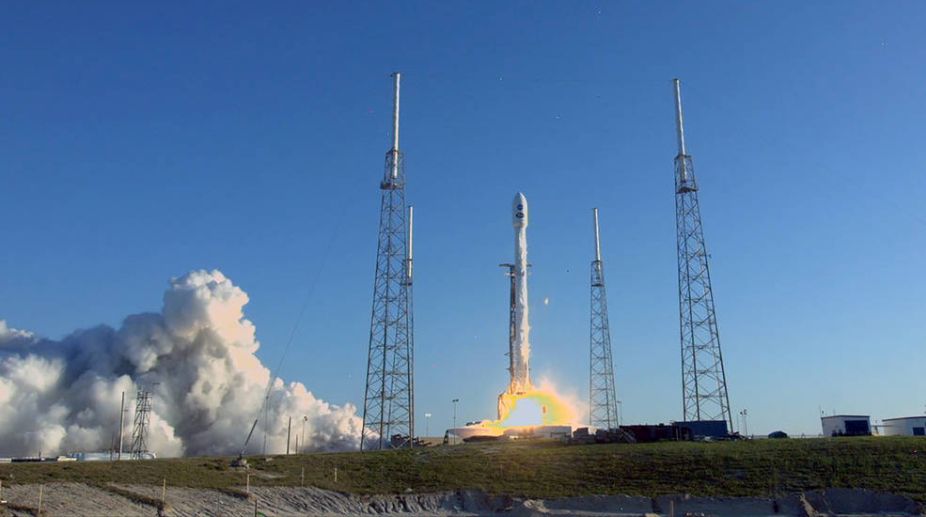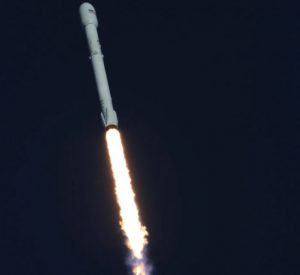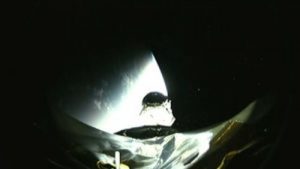Indian-Origin Sunita Williams flies to space aboard Boeing-NASA Starliner spacecraft
The 59-year-old Williams created history by becoming the first woman to fly on the maiden mission of a new human-rated spacecraft.
Riding a SpaceX Falcon rocket, TESS thundered away from the launch complex at Cape Canaveral Air Force Station in Florida at 6.51 pm EDT on Wednesday (4.21 am on Thursday, India time).

NASA successfully launched TESS on a SpaceX Falcon 9 on 18 April 18, 2018. (Photo: NASA Television)
NASA’s Transiting Exoplanet Survey Satellite, or TESS, has embarked on its hunt for new “habitable planets” around neighbouring stars.
Riding a SpaceX Falcon rocket, TESS thundered away from the launch complex at Cape Canaveral Air Force Station in Florida at 6.51 pm EDT on Wednesday (4.21 am on Thursday, India time). NASA said the countdown was uneventful “highlighted by excellent weather and healthy hardware”.
The satellite will scan the sky for at least two years, staring at the closest and brightest stars to find and identify explanets – the planets outside our own solar system.
Advertisement

“Liftoff of the SpaceX Falcon 9 rocket carrying TESS, a planet-hunting spacecraft that will search for new worlds beyond our solar system,” NASA Launch Commentator Josh Finch said.
According to NASA, TESS will be the first “space-based, all-sky surveyor” to hunt for exoplanets. The spacecraft is specifically searching for Earth-like planets that are close enough to our celestial neighborhood so that scientists can study them further.
“We are thrilled TESS is on its way to help us discover worlds we have yet to imagine, worlds that could possibly be habitable, or harbor life,” said Thomas Zurbuchen, associate administrator of NASA’s Science Mission Directorate in Washington.
After the liftoff, the Falcon 9 rocket sent the spacecraft on its way to orbit. At 7:53 pm, the twin solar arrays that will power the spacecraft successfully deployed.
“Wow, are we excited. We just had a perfect countdown and perfect launch of the TESS mission,” said Tim Dunn of NASA’s Launch Services Program. “The Falcon 9 continues to demonstrate what a reliable vehicle it has become,” Dunn said.
According to NASA, TESS will use six thruster burns to travel in a series of progressively elongated orbits over the course of several weeks to reach the Moon, which will provide a gravitational assist so that TESS can transfer into its 13.7-day final science orbit around Earth. The spacecraft will begin its work after approximately 60 days of check-out and instrument testing.

TESS will use the “transit method”, like the Kepler mission before it did, staring intently at the stars in a given section, watching for a passing (transiting) planet.
A transit occurs when a planet passes in front of its star from the observer’s perspective, causing a periodic and regular dip in the star’s brightness. More than 78 per cent of the approximately 3,700 confirmed exoplanets have been found using transits.
Launched in 2009, Kepler found more than 2,600 exoplanets, using this same method of watching for transits. Kepler focused on a given section of the sky and looked for Earth-like planets. Going a step further, TESS will scan a far larger area looking for stars 30-300 light-years away and target 30 to 100 times brighter stars.
The brightness of these target stars will allow researchers to use spectroscopy, the study of the absorption and emission of light, to determine a planet’s mass, density and atmospheric composition.
“Water, and other key molecules, in its atmosphere can give us hints about a planet’s capacity to harbour life,” NASA said in a press statement.
READ | All you want to know about TESS
Scientists have divided the sky into 26 sectors. TESS would use four unique wide-field cameras to map 13 sectors encompassing the southern sky during its first year of observations and 13 sectors of the northern sky during the second year, altogether covering 85 percent of the sky, NASA said in the press statement.
“With missions like the James Webb Space Telescope to help us study the details of these planets, we are ever the closer to discovering whether we are alone in the universe,” said Thomas Zurbuchen.
TESS was earlier scheduled to launch on Monday (4.02 am on Tuesday, India time) but was rescheduled to conduct further Guidance, Navigation and Control analysis.
“One critical piece for the science return of TESS is the high data rate associated with its orbit,” said George Ricker, TESS principal investigator at the Massachusetts Institute of Technology’s (MIT) Kavli Institute for Astrophysics and Space Research in Cambridge. “Each time the spacecraft passes close to Earth, it will transmit full-frame images taken with the cameras. That’s one of the unique things TESS brings that was not possible before.”
Calling it the beginning of a new era of exoplanet research, Stephen Rinehart, TESS project scientist at NASA’s Goddard Space Flight Center in Greenbelt, Maryland, said, “The targets TESS finds are going to be fantastic subjects for research for decades to come,”
TESS is a NASA Astrophysics Explorer mission led and operated by MIT and managed by Goddard. George Ricker, of MIT’s Kavli Institute for Astrophysics and Space Research, serves as principal investigator for the mission. TESS’s four wide-field cameras were developed by MIT’s Lincoln Laboratory. Additional partners include Orbital ATK, NASA’s Ames Research Center, the Harvard-Smithsonian Center for Astrophysics, and the Space Telescope Science Institute. More than a dozen universities, research institutes and observatories worldwide are participants in the mission.
Advertisement